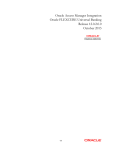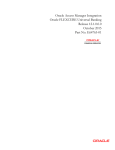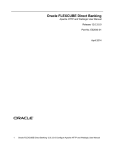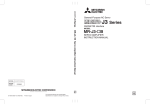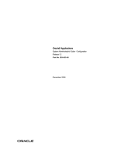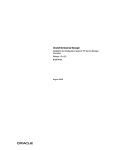Download Oracle Access Manager Integration
Transcript
Oracle Access Manager Integration Oracle FLEXCUBE Investor Servicing Release 12.0.4.0.0 September 2014 1-1 Table of Contents 1. PREFACE ........................................................................................................................................................ 1-3 1.1 INTRODUCTION ........................................................................................................................................... 1-3 1.2 AUDIENCE .................................................................................................................................................. 1-3 1.3 ABBREVIATIONS ......................................................................................................................................... 1-3 1.4 DOCUMENTATION ACCESSIBILITY .............................................................................................................. 1-3 1.5 ORGANIZATION .......................................................................................................................................... 1-3 1.6 GLOSSARY OF ICONS .................................................................................................................................. 1-3 1.6.1 Related Documents ............................................................................................................................ 1-4 2. ENABLING SINGLE SIGN-ON WITH ORACLE ACCESS MANAGER ............................................... 2-1 2.1 INTRODUCTION ........................................................................................................................................... 2-1 2.2 BACKGROUND AND PREREQUISITES ........................................................................................................... 2-1 2.2.1 Software Requirements ...................................................................................................................... 2-1 2.3 BACKGROUND OF SSO RELATED COMPONENTS .......................................................................................... 2-2 2.3.1 Oracle Access Manager (OAM)......................................................................................................... 2-2 2.3.2 LDAP Directory Server ..................................................................................................................... 2-2 2.3.3 WebGate/AccessGate ......................................................................................................................... 2-2 2.3.4 Oracle Adaptive Access Manager ...................................................................................................... 2-3 2.4 CONFIGURATION ........................................................................................................................................ 2-3 2.4.1 Pre-requisites ..................................................................................................................................... 2-3 2.5 ENABLING SSL FOR WEBLOGIC AND OAM CONSOLE ................................................................................ 2-3 2.5.1 Self-signed Certificate Creation: ....................................................................................................... 2-3 2.5.2 Configuring Weblogic Console .......................................................................................................... 2-5 2.5.3 Configuring SSL Mode in Oracle Internet Directory ........................................................................ 2-9 2.6 CONFIGURING SSO IN OAM CONSOLE .................................................................................................... 2-12 2.6.1 Identity Store Creation..................................................................................................................... 2-13 2.6.2 Creating Authentication Module...................................................................................................... 2-16 2.6.3 Creating Authentication Scheme ...................................................................................................... 2-17 2.6.4 Creating OAM 11g Webgate ............................................................................................................ 2-21 2.6.5 Post OAM Webgate 11g Creation .................................................................................................... 2-27 2.7 FIRST LAUNCH OF FLEXCUBE AFTER INSTALLATION ............................................................................. 2-34 2.7.1 Parameter Maintenance .................................................................................................................. 2-34 2.7.2 Maintaining LDAP DN for FLEXCUBE users ................................................................................ 2-35 2.7.3 Launching FLEXCUBE ................................................................................................................... 2-36 2.7.4 Signoff in a SSO Situation ................................................................................................................ 2-43 1-2 1. 1.1 Preface Introduction This manual discusses the integration of Oracle FLEXCUBE Investor Servicing and the Oracle Access Manager system. The configurations required for proper functioning of this integration and further processing are documented in this manual. 1.2 Audience This manual is intended for the following User/User Roles: 1.3 1.4 Role Function Back office data entry Clerks Input functions for maintenance related to the interface. Implementation team Implementation of Oracle FLEXCUBE Investor Servicing Abbreviations Abbreviation Description System Unless specified, it shall always refer to Oracle FLECUBE OAM Oracle Access Manager IS Investor Servicing SSO Single Sign-on LDAP Lightweight Directory Access Protocol Documentation Accessibility For information about Oracle's commitment to accessibility, visit the Oracle Accessibility Program website at http://www.oracle.com/pls/topic/lookup?ctx=acc&id=docacc. 1.5 Organization This manual is organized into the following chapters: 1.6 Chapter 1 Preface gives information on the intended audience. It also lists the various chapters covered in this User Manual. Chapter 2 Enabling Single Sign-on (SSO) with Oracle Access Manager discusses the method to integrate Oracle FLEXCUBE with Oracle Access Manager for Single Sign-on. Glossary of Icons This User Manual may refer to all or some of the following icons. 1-3 Icons Function Exit Add row Delete row Option List 1.6.1 Related Documents You may refer the following manual for more information Oracle Access Manager User Manual (not included with Oracle FLEXCUBE User Manuals) 1-4 2. 2.1 Enabling Single Sign-on with Oracle Access Manager Introduction For the purpose of single sign-on FLEXCUBE is qualified with Oracle Identity Management 11.1.2 (Fusion Middleware 11gR2) – specifically using the Access Manager component of Oracle Identity Management. This feature is available in FLEXCUE since the release FC IS V.UM 7.3.0.0.0.0.0 . This document provides an understanding as to how single sign-on can be enabled for a FLEXCUBE deployment using Oracle Fusion Middleware 11gR2. In addition to providing a background to the various components of the deployment, this document also talks about Configuration to be done in FLEXCUBE and Oracle Access Manager to enable single sign-on using Oracle Internet Directory as a LDAP server. 2.2 Background and Prerequisites 2.2.1 Software Requirements Oracle Identity and Access Management 11g R2 - 11.1.2.2.0 Oracle Access Manager – 11.1.2.2.0 Oracle Fusion Middleware Web Tier Utilities 11g Patch Set 6 - 11.1.1.7.0 Oracle HTTP Server Oracle Access Manager OHS 11gR2 WebGates - 11.1.2.2.0 Oracle Access Manager patch set – 18333689, 19269297, 18662903 Optional: Oracle Adaptive Access Manager – 11.1.2.2.0 (Strong Authentication purpose only ) Note *: In case of java.security.InvalidKeyException: Illegal key size error in Admin Server, while starting the OAM Server based applications, then refer Oracle Support Document ID: 1901181.1. LDAP Directory Server Please make sure that the LDAP server to be used for FLEXCUBE Single Sign on deployment is certified to work with OAM. List of few LDAP Directory servers supported as per OAM document (note – this is an indicative list. The conclusive list can be obtained from the Oracle Access Manager documentation. Though we have only use OID for our testing purposes): Oracle Internet Directory Active Directory ADAM ADSI Data Anywhere (Oracle Virtual Directory) IBM Directory Server NDS 2-1 Sun Directory Server Oracle Weblogic (10.3.6) For the purpose of achieving single sign on for FLEXCUBE in FMW 11gR2, it is necessary for the weblogic instance to have an explicit Oracle HTTP server (OHS). 2.3 Background of SSO related components 2.3.1 Oracle Access Manager (OAM) Oracle Access Manager consists of the Access System and the Identity System. The Access System secures applications by providing centralized authentication, authorization and auditing to enable single sign-on and secure access control across enterprise resources. The Identity System manages information about individuals, groups and organizations. It enables delegated administration of users, as well as selfregistration interfaces with approval workflows. These systems integrate seamlessly. The backend repository for the Access Manager is an LDAP-based directory service that can be a combination of a multiple directory servers, which is leveraged for two main purposes: As the store for policy, configuration and workflow related data, which is used and managed by the Access and Identity Systems As the identity store, containing the user, group and organization data that is managed through the Identity System and is used by the Access System to evaluate access policies. 2.3.2 LDAP Directory Server To integrate Flexcube with OAM to achieve Single Sign-on feature, Flexcube’s password policy management, like password syntax and password expiry parameters will no longer be handled by Flexcube. Instead, the password policy management can be delegated to the Directory Server. All password policy enforcements would be on the LDAP user id’s password and NOT Flexcube application users’ passwords. 2.3.3 WebGate/AccessGate A WebGate is a Web server plug-in that is shipped out-of-the-box with Oracle Access Manager. The WebGate intercepts HTTP requests from users for Web resources and forwards it to the Access Server for authentication and authorization. Whether you need a WebGate or an AccessGate depends on your use of the Oracle Access Manager Authentication provider. For instance, the: Identity Asserter for Single Sign-On: Requires a separate WebGate and configuration profile for each application to define perimeter authentication. Ensure that the Access Management Service is On. Authenticator or Oracle Web Services Manager: Requires a separate AccessGate and configuration profile for each application. Ensure that the Access Management Service is On. 2-2 2.3.4 Oracle Adaptive Access Manager Oracle Adaptive Access Manager provides an innovative, comprehensive feature set to help organizations prevent fraud and misuse. Strengthening standard authentication mechanisms, innovative risk-based challenge methods, intuitive policy administration and integration across the Identity and Access Management Suite and with third party products make Oracle Adaptive Access Manager uniquely flexible and effective. Oracle Adaptive Access Manager provides real-time and batch risk analytics to combat fraud and misuse across multiple channels of access. Real-time evaluation of multiple data types helps stop fraud as it occurs. Oracle Adaptive Access Manager makes exposing sensitive data, transactions and business processes to consumers, remote employees or partners via your intranet and extranet safer. Oracle Adaptive Access Manager provides an extensive set of capabilities including device fingerprinting, real-time behavioral profiling and risk analytics that can be harnessed across both Web and mobile channels. It also provides risk-based authentication methods including knowledge-based authentication (KBA) challenge infrastructure with Answer Logic and OTP Anywhere server-generated one-time passwords, delivered out of band via Short Message Service (SMS), e-mail or Instant Messaging (IM) delivery channels. Oracle Adaptive Access Manager also provides standard integration with Oracle Identity Management, the industry leading identity management and Web Single Sign-On products, which are integrated with leading enterprise applications. 2.4 Configuration 2.4.1 Pre-requisites 2.5 The steps provided below assume that FLEXCUBE has already been deployed and is working (without single sign-on) The below provided steps assume that Oracle Access Manager and the LDAP server have been installed already and the requisite setup are already done with respect to connecting the two along with Weblogic’s Identity Asserter. Enabling SSL for Weblogic and OAM Console 2.5.1 Self-signed Certificate Creation: To enable SSL mode, WebLogic requires a keystore which contains private and trusted certificates. We have to use the same version of JDK (which is used by Weblogic Domain) to create the keystore and certificates, otherwise it may lead to many difficulties (suggested by Oracle Support). Keytool utility available in Java JDK will be used to create Keystore. In command prompt set PATH to the JDK\bin location. Follow the below steps to create keystore and self-signed certificates: 2.5.1.1 Keystore Creation keytool -genkey -keystore <keystore_name.jks> -alias <alias_name> -dname "CN=<hostname>, OU=<Organization Unit>, O=<Organization>, L=<Location>, ST=<State>, C=<Country_Code>" -keyalg <Key Algorithm> -sigalg <Signature Algorithm> -keysize <key size> -validity <Number of Days> -keypass <Private key Password> -storepass <Store Password> For example: keytool -genkey -keystore AdminFlexcubeKeyStore.jks -alias FlexcubeCert -dname "CN=ofss00001.in.oracle.com, OU=OFSS, O=OFSS, L=Chennai, ST=TN, C=IN" -keyalg "RSA" -sigalg "SHA1withRSA" -keysize 2048 -validity 3650 -keypass Password@123 -storepass Password@123 2-3 Note: CN=ofss00001.in.oracle.com is the Host Name of the weblogic server 2.5.1.2 Export private key as certificate keytool -export -v -alias <alias_name> -file <export_certificate_file_name_with_location.cer> -keystore <keystore_name.jks> > -keypass <Private key Password> -storepass <Store Password> For example: keytool -export -v -alias FlexcubeCert -file AdminFlexcubeCert.cer -keystore AdminFlexcubeKeyStore.jks -keypass Password@123 -storepass Password@123 If successful the following message will be displayed : Certificate stored in file < AdminFlexcubeCert.cer> 2.5.1.3 Import as trusted certificate keytool -import -v -trustcacerts -alias rootcacert -file <export_certificate_file_name_with_location.cer> keystore <keystore_name.jks> > -keypass <Private key Password> -storepass <Store Password> For example: keytool -import -v -trustcacerts -alias rootcacert -file AdminFlexcubeCert.cer -keystore AdminFlexcubeKeyStore.jks -keypass Password@123 -storepass Password@123 References: Oracle Support Articles (Article ID 1281035.1, Article ID 1218695.1), in case of Certificates issued by the Trusted Authorities 2-4 2.5.2 Configuring Weblogic Console After domain creation, follow the below steps to enable SSL in weblogic Admin server and OAM Server. 2.5.2.1 Select Admin Server to enable SSL options 2.5.2.2 Follow the steps in General Tab as shown below: 1. Select SSL Listen Port Enabled, Client Cert Proxy Enabled, Weblogic Plug-In Enabled. 2. Click on Save. 2-5 2.5.2.3 Follow the steps in Keystores Tab as shown below: 1. Click Change and select Keystores as Custom Identity and Custom Trust. 2. Click on Save. Keystores as Custom Identity and Custom Trust is as suggested by Oracle Support Team. 2-6 2.5.2.4 Follow the steps in Keystores Tab as shown below: 1. Enter Custom Identity Keystore and Custom Trust Keystore same as the Keystore Name created in step 3.2.1.1 with full path. 2. Enter Custom Identity Keystore Type and Custom Trust Keystore Type as jks. 3. Enter Custom Identity Keystore Passphrase, Confirm Custom Identity Keystore Passphrase, Custom Trust Keystore Passphrase and Confirm Custom Trust Keystore Passphrase same as the Store Password entered in step 3.2.1.1. 4. Click on Save. 2.5.2.5 Follow the steps in SSL Tab as shown below: 1. Enter Private Key Alias as same as the alias name entered in step 3.2.1.1. 2. Enter Private Key Passphrase and Confirm Private Key Passphrase as same as the Private Key Password entered in step 3.2.1.1. 3. Change the Hostname Verification to None. 4. Click on Save. 2-7 5. Select OAM Server to enable SSL options and Repeat the steps performed in 2.2.2.2 to 2.2.2.5 6. Now the admin server and OAM servers are SSL enabled. Restart both the servers. 2-8 2.5.3 Configuring SSL Mode in Oracle Internet Directory To enable SSL for OID LDAP Server refer, follow the below steps. 1. Login to the Enterprise Manager Console of the domain, in which Oracle Internet Directory is associated. 2. Click ‘Create Self-Signed Wallet’. 3. Enter the Details as below and Click ‘OK’. 2-9 4. Click . 5. Select the Trusted Certificate and Click ‘Export’. 6. Click ‘Export Trusted Certificate’ and save the certificate file. 2-10 7. Click ‘Server Properties’. 8. Click ‘Change SSL Settings’. 9. Select the Wallet, SSL Authentication as Server Authentication, Cipher Suite, SSL Protocal Version as below and click ‘OK’. 2-11 10. Click ‘Apply’. 2.5.3.1 Import LDAP Server SSL Certificate into OAM Server We have to import the LDAP – Server certificatefile into OAM server’s JAVA_HOME/jre/lib/security/cacerts. Default Password is “changeit”. For eg: keytool -import -v -trustcacerts -alias ldapcacert –file ldap_server_certificate.cer -keystore JAVA_HOME/jre/lib/security/cacerts -storepass changeit Restart Both OID & OAM Server. 2.6 Configuring SSO in OAM Console After installing OAM, Webtier Utilities and Webgate, extend the Weblogic domain to create OAM server. Follow the post installation scripts deployWebGate and EditHttpConf as provided in (http://docs.oracle.com/cd/E37115_01/install.1112/e38922/webgate_ohs.htm#CACDEJAD) 2-12 Refer the Oracle Support Document ID: 1678062.1 , before configuring Webgate against Oracle HTTP Server. 2.6.1 Identity Store Creation 1. To create new User Identity Store, Login to OAM Console and Click ‘User Identity Store’ under Configuration. 2. Click ‘Create’ under OAM ID Stores. 2-13 3. Enter the below details in the Create User Identity Store Form Choose Store Type as OID: Oracle Internet Directory. Location: LDAP server Host name and Port Number in <HOSTNAME>:SSL PORT format Select Enable SSL check box Bind DN: Admin User name to connect the LDAP Server Password: Admin Password to connect the LDAP Server Login ID Attribute: Specify the LDAP attribute from which the login ID specifying the User will be extracted. User Search Base: Full DN for the node at which enterprise users are stored in the directory; for example, cn=Users,realm_DN. Group Search Base: Currently only static groups are supported, with the uniquemember attribute. The node in the directory information tree (DIT) under which group data is stored, and the highest possible base for all group data searches. 2-14 4. Click ‘Test Connection’ to validate the Credentials Passed. 5. Click ‘Apply’ to Create the User Identity Store. Note: User Identity Store will be created only if valid LDAP Parameters are passed. 2-15 2.6.2 Creating Authentication Module 1. Click on in Access Manager to Create LDAP Authentication Modules . 2. Click ‘Apply’ to create Authentication Module. 3. Choose the User Identity Created. 2-16 Refer the section ‘Identity Store Location’ of this document. 2.6.3 Creating Authentication Scheme 1. Click ‘Create Authentication Scheme’ under Access Manager . Select any of the challenge method for creating an authentication Scheme as explained below and refer to OAM documentation for more details on the same. http://docs.oracle.com/cd/E27559_01/admin.1112/e27239/shared.htm#BABFCIHA 2-17 2.6.3.1.1 Basic Style Authentication Scheme Enter the below details and click ‘Apply’: Name : Name of the Authentication Scheme Authentication Level :1 Challenge Method : BASIC Challenge Redirect URL : /oam/server Authentication Module : Authentication Module Refer the section ‘Creating Authentication Module’ of this document. Challenge Parameters : ssoCookie=Secure contextType=default contextValue=/oam challenge_url=/CredCollectServlet/BASIC We need to add the 'enforce-valid-basic-auth-credentials' tag to the config.xml file ,located under <weblogic deployment path>/user_projects/domains/<MyDomain>/config/. The tag must be inserted within the <security-configuration> tag as follows: [Just above </securityconfiguration> tag] <enforce-valid-basic-auth-credentials>false</enforce-valid-basic-auth-credentials> 2-18 2.6.3.2 Form Style Authentication Scheme Enter the below details and click ‘Apply’: Name : Name of the Authentication Scheme Authentication Level :2 Challenge Method : FORM Challenge Redirect URL : /oam/server Authentication Module : Authentication Module Refer the section ‘Creating Authentication Module’ of this document. Challenge URL : /pages/login.jsp Context Type : default Context Value : /oam Challenge Parameters : ssoCookie=Secure 2-19 2.6.3.3 KBA Based Strong Authentication Scheme ( Only in case OAAM is used) Enter the Below Details and click ‘Apply’: Name : Name of the Authentication Scheme Authentication Level :2 Challenge Method : FORM Challenge Redirect URL : /oam/server Authentication Module : Authentication Module Refer the section ‘Creating Authentication Module’ of this document. Challenge URL : /pages/oaam/login.jsp Context Type : default Context Value : /oam Challenge Parameters : ssoCookie=Secure oaamPostAuth=true oaamPreAuth=true 2-20 2.6.4 Creating OAM 11g Webgate Follow the below steps to create a Webgate: 1. Click ‘Server Instances’ under Configuration. 2-21 2. Click ‘Search’. 3. Edit oam_server1. 4. Modify the Mode from Open to Simple and click ‘Apply’. 2-22 2-23 5. Click on Create 11g Webgate under Access Manager . 6. Enter the below and Click ‘Apply’: Name : Custom Webgate Name Base URL : The host and port of the computer on which the Web server for the Webgate is installed. For example, http://example_host:port or https://example_host:port. The port number is optional. Security : Simple Protected Resource List : for FCUBS : /FCJNeoWeb For FCIS : /FCISNeoWeb User Defined Parameters : filterOAMAuthnCookie=false 2-24 7. Once the OAM 11g Webgate is created, Change the parameter from proxySSLHeaderVar=IS_SSL to proxySSLHeaderVar=ssl along with other parameters in User Defined Parameters. 8. Click ‘Apply’. 2-25 9. Change the value of Mode back to Open in oam_server1 on Server Instance and click ‘Apply’. Refer ‘Creating OAM 11g Webgate’ section of this document. 2-26 2.6.5 Post OAM Webgate 11g Creation Follow the below steps to configure the webgate created . 2.6.5.1 Application Domains Changes 1. Click ‘Application Domains’ under Access Manager 2. Click ‘Search’ to find the 11g Webgate. Refer the section ‘Creating OAM 11g Creation’ of this document. 2-27 3. Click ‘Authentication Polices’. 4. Click ‘Protected Resource Policy’. 5. Choose the Authentication Scheme created earlier in ‘Creating Authentication Scheme’. Refer the section ‘Creating Authentication Scheme’ of this document. 2-28 6. Click ‘Responses’ tab and click ‘+’ button to Add ‘DN’ variable to the Response Header. 7. Enter the following values in the Add Response Window: Type : Header Name : DN Value : $user.attr.dn 2-29 8. Click on Apply to Save the Changes 9. Click ‘Authorization Policies’ and ‘Protected Resource Policy’. 10. Click ‘Response’ and click on ‘+’ button to Add ‘DN’ variable to the Response Header. 11. Enter the following values in the Add Response Window : Type : Header Name : DN Value : $user.attr.dn 2-30 12. Click ‘Apply’ to Save the changes. 2.6.5.2 Copying Generated Files and Artifacts to the Oracle HTTP Server WebGate Instance Perform the following steps to copy the artifacts generated while creating the Oracle 11g Webgate to the Webgate installation directory: Navigate to <DOMAIN_HOME>/output/$WebgateAgentName Select the following files ObAccessClient.xml password.xml cwallet.sso 2-31 Copy the files to <ORACLE_MIDDLEWARE>/<ORACLE_WIBTIER_HOME> /instances/instance1/ config/OHS/ohs1/webgate/config/ Select the remaining 2 files aaa_key.pem aaa_cert.pem Copy the files to <ORACLE_MIDDLEWARE>/<ORACLE_WIBTIER_HOME> /instances/instance1/ config/OHS/ohs1/webgate/config/simple 2.6.5.3 Add the Application Certificates to Oracle HTTP Server to work in SSL mode. Use the ORAPKI tool to import the Flexcube and OAM Server certificates to Oracle HTTP Server. Add <Oracle_MIDDLEWARE>/oracle_common/bin to PATH environment variable and also set JAVA_HOME environment variable. Execute the below command in the command line. orapki wallet add -wallet <Oracle_MIDDLEWARE>/<ORACLE_WEBTIER_HOME>/instances/instance1/config/OHS/ohs1/keystore s/default -trusted_cert -cert <export_certificate_file_name_with_location.cer> -auto_login_only Note: Certificate has to be imported into OHS Wallet. 2.6.5.4 Configuring mod_wl_ohs for Oracle HTTP server Routing To enable the Oracle HTTP Server instances to route to applications deployed on the Oracle Weblogic Server, add the directive shown below to the mod_wl_ohs.conf file available in <ORACLE_MIDDLEWARE> /<ORACLE_WEBTIER_HOME>/instances/instance1/config/OHS/ohs1. <Location /FCJNeoWeb> SetHandler weblogic-handler WebLogicHost ofss00002.in.oracle.com WeblogicPort 7002 WLProxySSL ON SecureProxy ON WLSSLWallet "<ORACLE_MIDDLEWARE>/<ORACLE_WEBTIER_HOME>/instances/instance1/config/OHS/ohs1/keystores/default" </Location> Note: In the above example, ofss00002.in.oracle.com is the server name where the Flexcube Application is deployed, 7002 is the SSL port and FCJNeoWeb is the context root of the FLEXCUBE application 2.6.5.5 Verify the Webgate 11g Agent Created After configuring webgate 11g agent , launch the URL https://<hostname>:<ohs_Port>/ohs/modules/webgate.cgi?progid=1 to verify whether the webgate configuration is working fine. If the URL launches a screen as below then the webgate configuration is working fine. Note *: To enable this option refer Oracle Doc ID: 1624131.1 2-32 2.6.5.6 Using OAM Test Tool (This step is not mandatory) There is a test tool provided in OAM software which helps us to check the response parameter values. The test tool is available in <OAM Install Dir>\ oam\server\tester. For eg. D:\weblogic\Middleware\Oracle_IDM1\oam\server\tester Use java -jar oamtest.jar to launch the OAM test tool. 2-33 2.7 First launch of FLEXCUBE after installation After installing FLEXCUBE and while launching it for first time, the normal login screen with userid and password will appear. This is because the bank parameter maintenance will have the value for sso_intalled set to ‘N’ by default during installation. 2.7.1 Parameter Maintenance 2.7.1.1 Bank Parameter maintenance - IS To enable SSO in FLEXCUBE IS, login into the application and enable “SSO Enabled” Check box in “Bank Maintenance [SMDBANKP]” screen. 2-34 2.7.1.2 Parameters Maintenance – IS There is no such a screen to maintain the SSO Enabled Parameter in FLEXCUBE Investor Servicing. 2.7.2 Maintaining LDAP DN for FLEXCUBE users For each user id in FLEXCUBE a user has to be created in the LDAP. When creating the user in LDAP, ensure that the DN used is same as the LDAP DN value that will be updated in user maintenance form. Once the user is created in LDAP go to the user maintenance form in FCIS. If the FCIS user already exists then unlock the user and update the LDAP DN value which was set when creating the user in LDAP. Click on Validate button to check whether any other user is having the same LDAP DN value. LDAP DN value should be entered as complete DN value. eg. cn=FCUSR,cn=Users,dc=oracle,dc=com 2-35 For FLEXCUBE - IS 2.7.3 Launching FLEXCUBE After setting up FLEXCUBE to work on Single Sign on mode, navigate to the URL https://<hostname>:<OHS SSL Port>/<Context Root> from your browser eg: https://ofss00001.in.oracle.com:4443/FCISNeoWeb Since the resource is protected, the WebGate challenges the user for credentials as shown below. 2-36 2.7.3.1 Basic Style Challenge by Webgate 2-37 2.7.3.2 Form Style Challenge by Webgate 2.7.3.3 KBA Based Strong Authentication Challenge by Webgate( Only when OAAM is used) 2-38 First Time Login 2-39 2-40 Post First Login 2-41 Once the user is authenticated and authorized to access the resource, the request gets redirected to normal FLEXCUBE application and it will take the user to Home Branch. 2-42 2.7.3.4 After SSO Login FLEXCUBE Application launch - Home Branch / Module 2.7.4 Signoff in a SSO Situation FLEXCUBE does not provide for single signoff currently, i.e., when a user signs off in FLEXCUBE, the session established with Oracle Access Manager by the user will not be modified in any manner. In a SSO situation the “Exit” and “Logoff” actions in FLEXCUBE will function as “Exit”, i.e., on clicking these, the user will “exit” FLEXCUBE and will need to re-launch FLEXCUBE using the FLEXCUBE launch URL. 2-43 Oracle Access Manager Integration [September] [2014] Version 12.0.4.0.0 Oracle Financial Services Software Limited Oracle Park Off Western Express Highway Goregaon (East) Mumbai, Maharashtra 400 063 India Worldwide Inquiries: Phone: +91 22 6718 3000 Fax:+91 22 6718 3001 www.oracle.com/financialservices/ Copyright © [2007], [2014], Oracle and/or its affiliates. All rights reserved. Oracle and Java are registered trademarks of Oracle and/or its affiliates. Other names may be trademarks of their respective owners. U.S. GOVERNMENT END USERS: Oracle programs, including any operating system, integrated software, any programs installed on the hardware, and/or documentation, delivered to U.S. Government end users are "commercial computer software" pursuant to the applicable Federal Acquisition Regulation and agency-specific supplemental regulations. As such, use, duplication, disclosure, modification, and adaptation of the programs, including any operating system, integrated software, any programs installed on the hardware, and/or documentation, shall be subject to license terms and license restrictions applicable to the programs. No other rights are granted to the U.S. Government. This software or hardware is developed for general use in a variety of information management applications. It is not developed or intended for use in any inherently dangerous applications, including applications that may create a risk of personal injury. If you use this software or hardware in dangerous applications, then you shall be responsible to take all appropriate failsafe, backup, redundancy, and other measures to ensure its safe use. Oracle Corporation and its affiliates disclaim any liability for any damages caused by use of this software or hardware in dangerous applications. This software and related documentation are provided under a license agreement containing restrictions on use and disclosure and are protected by intellectual property laws. Except as expressly permitted in your license agreement or allowed by law, you may not use, copy, reproduce, translate, broadcast, modify, license, transmit, distribute, exhibit, perform, publish or display any part, in any form, or by any means. Reverse engineering, disassembly, or decompilation of this software, unless required by law for interoperability, is prohibited. The information contained herein is subject to change without notice and is not warranted to be error-free. If you find any errors, please report them to us in writing. This software or hardware and documentation may provide access to or information on content, products and services from third parties. Oracle Corporation and its affiliates are not responsible for and expressly disclaim all warranties of any kind with respect to third-party content, products, and services. Oracle Corporation and its affiliates will not be responsible for any loss, costs, or damages incurred due to your access to or use of third-party content, products, or services. 2-1
















































